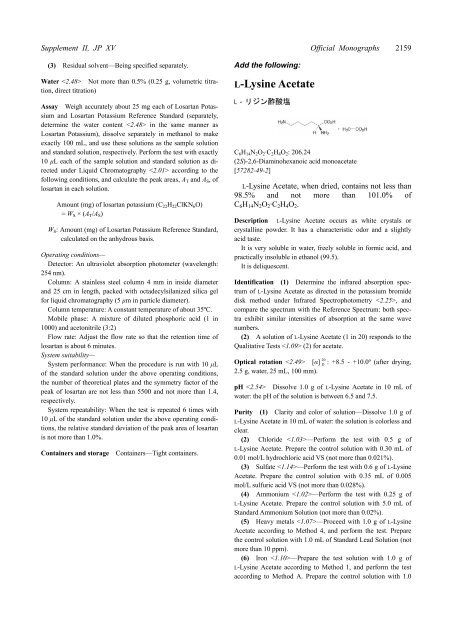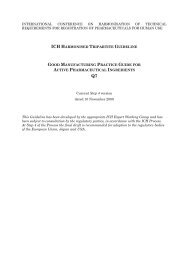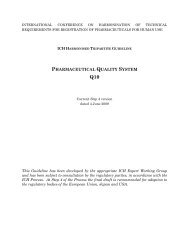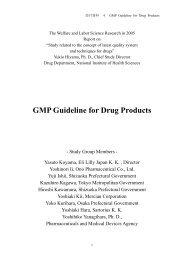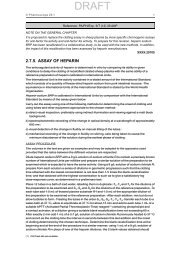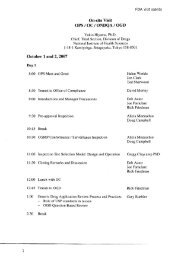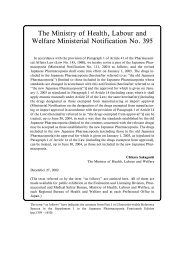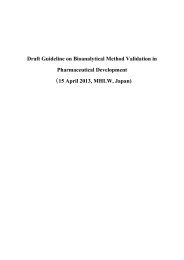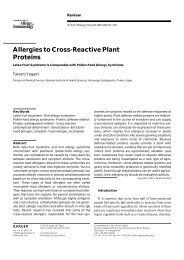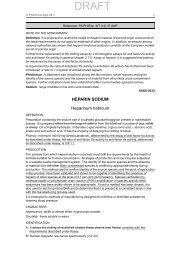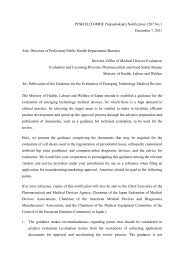supplement ii to the japanese pharmacopoeia fifteenth edition - NIHS
supplement ii to the japanese pharmacopoeia fifteenth edition - NIHS
supplement ii to the japanese pharmacopoeia fifteenth edition - NIHS
Create successful ePaper yourself
Turn your PDF publications into a flip-book with our unique Google optimized e-Paper software.
Supplement II, JP XV Official Monographs 2159(3) Residual solvent—Being specified separately.Water Not more than 0.5% (0.25 g, volumetric titration,direct titration)Assay Weigh accurately about 25 mg each of Losartan Potassiumand Losartan Potassium Reference Standard (separately,determine <strong>the</strong> water content in <strong>the</strong> same manner asLosartan Potassium), dissolve separately in methanol <strong>to</strong> makeexactly 100 mL, and use <strong>the</strong>se solutions as <strong>the</strong> sample solutionand standard solution, respectively. Perform <strong>the</strong> test with exactly10 µL each of <strong>the</strong> sample solution and standard solution as directedunder Liquid Chroma<strong>to</strong>graphy according <strong>to</strong> <strong>the</strong>following conditions, and calculate <strong>the</strong> peak areas, A T and A S , oflosartan in each solution.Amount (mg) of losartan potassium (C 22 H 22 ClKN 6 O)= W S × (A T /A S )W S : Amount (mg) of Losartan Potassium Reference Standard,calculated on <strong>the</strong> anhydrous basis.Operating conditions—Detec<strong>to</strong>r: An ultraviolet absorption pho<strong>to</strong>meter (wavelength:254 nm).Column: A stainless steel column 4 mm in inside diameterand 25 cm in length, packed with octadecylsilanized silica gelfor liquid chroma<strong>to</strong>graphy (5 µm in particle diameter).Column temperature: A constant temperature of about 35ºC.Mobile phase: A mixture of diluted phosphoric acid (1 in1000) and ace<strong>to</strong>nitrile (3:2)Flow rate: Adjust <strong>the</strong> flow rate so that <strong>the</strong> retention time oflosartan is about 6 minutes.System suitability—System performance: When <strong>the</strong> procedure is run with 10 µLof <strong>the</strong> standard solution under <strong>the</strong> above operating conditions,<strong>the</strong> number of <strong>the</strong>oretical plates and <strong>the</strong> symmetry fac<strong>to</strong>r of <strong>the</strong>peak of losartan are not less than 5500 and not more than 1.4,respectively.System repeatability: When <strong>the</strong> test is repeated 6 times with10 µL of <strong>the</strong> standard solution under <strong>the</strong> above operating conditions,<strong>the</strong> relative standard deviation of <strong>the</strong> peak area of losartanis not more than 1.0%.Containers and s<strong>to</strong>rage Containers—Tight containers.Add <strong>the</strong> following:L-Lysine AcetateL‐リジン 酢 酸 塩C 6 H 14 N 2 O 2·C 2 H 4 O 2 : 206.24(2S)-2,6-Diaminohexanoic acid monoacetate[57282-49-2]L-Lysine Acetate, when dried, contains not less than98.5% and not more than 101.0% ofC 6 H 14 N 2 O 2·C 2 H 4 O 2 .Description L-Lysine Acetate occurs as white crystals orcrystalline powder. It has a characteristic odor and a slightlyacid taste.It is very soluble in water, freely soluble in formic acid, andpractically insoluble in ethanol (99.5).It is deliquescent.Identification (1) Determine <strong>the</strong> infrared absorption spectrumof L-Lysine Acetate as directed in <strong>the</strong> potassium bromidedisk method under Infrared Spectropho<strong>to</strong>metry , andcompare <strong>the</strong> spectrum with <strong>the</strong> Reference Spectrum: both spectraexhibit similar intensities of absorption at <strong>the</strong> same wavenumbers.(2) A solution of L-Lysine Acetate (1 in 20) responds <strong>to</strong> <strong>the</strong>Qualitative Tests (2) for acetate.Optical rotation [α] 20D: +8.5 - +10.0º (after drying,2.5 g, water, 25 mL, 100 mm).pH Dissolve 1.0 g of L-Lysine Acetate in 10 mL ofwater: <strong>the</strong> pH of <strong>the</strong> solution is between 6.5 and 7.5.Purity (1) Clarity and color of solution—Dissolve 1.0 g ofL-Lysine Acetate in 10 mL of water: <strong>the</strong> solution is colorless andclear.(2) Chloride —Perform <strong>the</strong> test with 0.5 g ofL-Lysine Acetate. Prepare <strong>the</strong> control solution with 0.30 mL of0.01 mol/L hydrochloric acid VS (not more than 0.021%).(3) Sulfate —Perform <strong>the</strong> test with 0.6 g of L-LysineAcetate. Prepare <strong>the</strong> control solution with 0.35 mL of 0.005mol/L sulfuric acid VS (not more than 0.028%).(4) Ammonium —Perform <strong>the</strong> test with 0.25 g ofL-Lysine Acetate. Prepare <strong>the</strong> control solution with 5.0 mL ofStandard Ammonium Solution (not more than 0.02%).(5) Heavy metals —Proceed with 1.0 g of L-LysineAcetate according <strong>to</strong> Method 4, and perform <strong>the</strong> test. Prepare<strong>the</strong> control solution with 1.0 mL of Standard Lead Solution (notmore than 10 ppm).(6) Iron —Prepare <strong>the</strong> test solution with 1.0 g ofL-Lysine Acetate according <strong>to</strong> Method 1, and perform <strong>the</strong> testaccording <strong>to</strong> Method A. Prepare <strong>the</strong> control solution with 1.0


